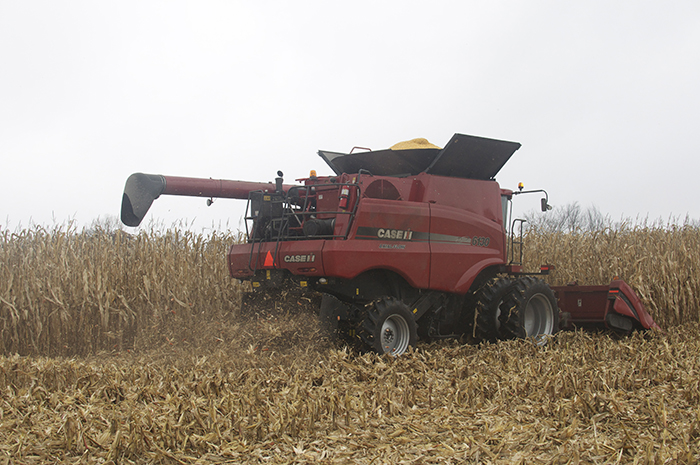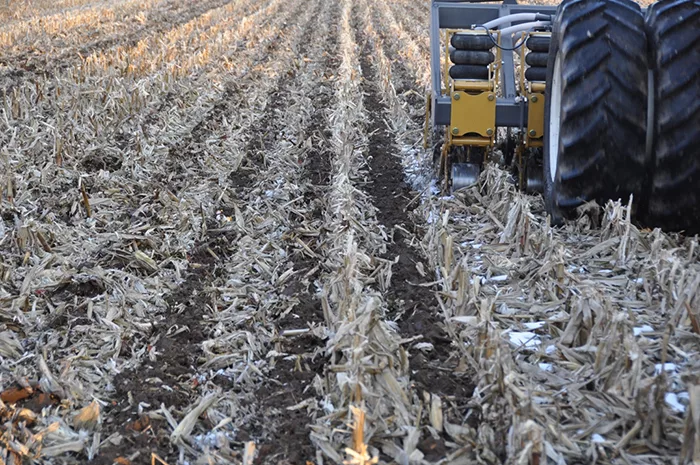The SoilWarrior zone tillage and nutrient management system manages heavy residue to create the ideal seedbed.
By Eric Moore, ETS Agronomist
Believe it or not, creating the ideal seedbed begins at harvest. While the main focus of the harvest season is tallying up yield results, it’s also the time of year for tackling crop residue management. After all, residue can have an impact on planting and eventually emergence.
Value of Crop Residue
First of all, growers should think about the value that crop residue adds to cropping systems. Consider a 200 bushel per acre corn crop and the residue remaining after harvest. On average, the stover from a 200 bushel per acre corn crop contains 90 pounds of nitrogen (N), 32 pounds of phosphate (P2O5), and 220 pounds of potassium (K2O)1. If we were to assign a monetary value to these nutrients, they could be worth in excess of $100 per acre.
Crop stover also adds value to our farms by reducing the evaporative portion of evapotranspiration during crop growth. Through research, we know that evaporation generally makes up 30% of evapotranspiration (ET). The more we reduce the evaporative part of ET, the more water is available for the transport of nutrients needed for crop growth.
Studies conducted by Kansas State University indicate that a soil surface covered with residue, even in a canopied crop, can reduce the amount of water lost to evaporation by 2.5-to-4.5 inches during the period from mid-June through mid-Sept., when compared to bare soil2.
If every inch of water available to a corn crop during grain fill yields an additional 11-13 bushels per acre, that residue could add in excess of 30 bushels per acre to corn yields when water becomes a limiting factor to crop production.

Be sure that the chopper/spreader attachments on your harvest equipment are capable of evenly distributing residue across the header width. Poor distribution of crop residues can create challenges in setting tillage and planting equipment.
Challenges of Crop Residue
Now let’s take a look at some of the challenges residues pose to growers in a high residue cropping system such as no-till. Crop residues can reduce soil temperatures by 10 degrees F at planting time when compared to clean tilled soils. Those cold soils can reduce nutrient availability and delay planting as it can take up to 7-10 days longer for residue covered soils to reach the 55 degree F soil temperature considered ideal for corn planting.
Managing residue with a cropping system such as strip-tillage allows growers to move residue away from the seeding zone, providing a warm, nutrient-rich soil for better germination. At the same time, growers can retain all the water savings benefits of crop residues left between the planted rows.
Top Residue Management Considerations
If we want to get the benefits of the nutrient value and water savings, as well as avoid the pitfalls of reduced nutrient availability and planting delays, it’s important that we properly manage residue starting at harvest. Here are a few things to consider when managing crop residues.
- Vertical residue is easier to manage than horizontal residue.
The more residue left standing at harvest means less residue on the soil that needs to be moved when creating cropping zones during a strip-till operation or at planting time. Standing residue also aids in capturing snowfall during the soil moisture recharge period and reduces the effects of desiccating wind once the crop emerges.
- Even residue distribution at harvest is critical.
Be sure that the chopper/spreader attachments on your harvest equipment are capable of evenly distributing residue across the header width. Poor distribution of crop residues can create challenges in setting tillage and planting equipment. The distribution of crop residues will affect the availability of the nutrients contained in the crop stover. If you were spending money to apply those nutrients as fertilizer to your fields you would want to get an accurate and even distribution. Unevenly distributed crop residues can lead to variability in soil temperature, resulting in uneven crop emergence.
- Size crop residue at harvest.
Creating relatively uniform crop residue helps in a couple areas. Making adjustments to zone cleaners on strip-till or planting equipment is much easier when the residue is of a similar length. Additionally, uniformly sized and distributed residue breaks down in a more consistent fashion, providing a more predictable release of beneficial nutrients to the growing crop.
Keep the following points in mind when sizing crop residue.
- Residue sized too long may not flow well through some tillage and planting equipment, especially in narrow row configurations.
- Larger sized residue also takes longer to decompose, delaying the release of nutrients back into the soil.
- Residue sized too small runs the risk of being moved by the wind, leading to poor distribution or even complete residue loss from the field.
- Residue management at harvest is only one piece of a complete residue management system.
- Consideration should be given to how crop residue will impact your nutrient placement for the next season’s crop.
- Decisions on how residues are sized and distributed at harvest should be made with your planting and fertilizing operations in mind.
In summary, realizing the benefits of crop residues to next year’s crop, while addressing the challenges associated with high residue farming, starts with residue management at harvest. Setting up and adjusting harvest equipment to distribute and size crop residues is an important part of an overall residue management plan that includes tillage and planting equipment as well.
References
1. Ag PhD. (2017, September). Corn Grain and Stover Nutrient Removal Charts. Retrieved from Ag PhD website: http://www.agphd.com/resources/nutrient-removal-charts/corn-grain-and-stover-nutrient-removal-charts/
2. Klocke, N. L. (2004). Crop Residue and Soil Water Evaporation. Retrieved from Kansas State University: https://www.ksre.k-state.edu/irrigate/reports/Klocke.pdf






